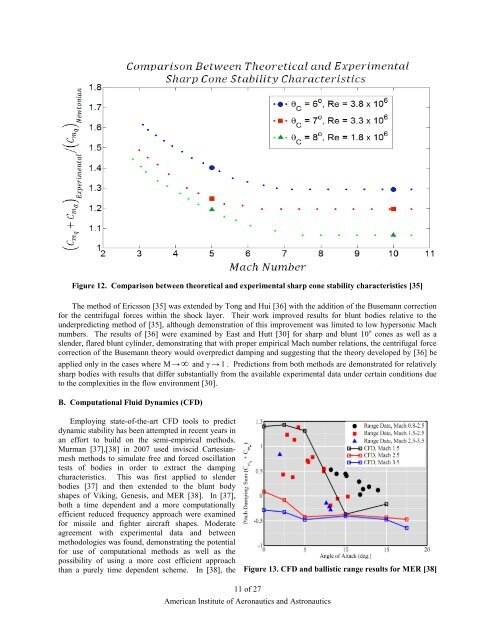Survey of Blunt Body Dynamic Stability in Supersonic Flow
Survey of Blunt Body Dynamic Stability in Supersonic Flow
Survey of Blunt Body Dynamic Stability in Supersonic Flow
Create successful ePaper yourself
Turn your PDF publications into a flip-book with our unique Google optimized e-Paper software.
Figure 12. Comparison between theoretical and experimental sharp cone stability characteristics [35]<br />
The method <strong>of</strong> Ericsson [35] was extended by Tong and Hui [36] with the addition <strong>of</strong> the Busemann correction<br />
for the centrifugal forces with<strong>in</strong> the shock layer. Their work improved results for blunt bodies relative to the<br />
underpredict<strong>in</strong>g method <strong>of</strong> [35], although demonstration <strong>of</strong> this improvement was limited to low hypersonic Mach<br />
numbers. The results <strong>of</strong> [36] were exam<strong>in</strong>ed by East and Hutt [30] for sharp and blunt 10 o cones as well as a<br />
slender, flared blunt cyl<strong>in</strong>der, demonstrat<strong>in</strong>g that with proper empirical Mach number relations, the centrifugal force<br />
correction <strong>of</strong> the Busemann theory would overpredict damp<strong>in</strong>g and suggest<strong>in</strong>g that the theory developed by [36] be<br />
applied only <strong>in</strong> the cases where M→∞ and γ → 1 . Predictions from both methods are demonstrated for relatively<br />
sharp bodies with results that differ substantially from the available experimental data under certa<strong>in</strong> conditions due<br />
to the complexities <strong>in</strong> the flow environment [30].<br />
B. Computational Fluid <strong>Dynamic</strong>s (CFD)<br />
Employ<strong>in</strong>g state-<strong>of</strong>-the-art CFD tools to predict<br />
dynamic stability has been attempted <strong>in</strong> recent years <strong>in</strong><br />
an effort to build on the semi-empirical methods.<br />
Murman [37],[38] <strong>in</strong> 2007 used <strong>in</strong>viscid Cartesianmesh<br />
methods to simulate free and forced oscillation<br />
tests <strong>of</strong> bodies <strong>in</strong> order to extract the damp<strong>in</strong>g<br />
characteristics. This was first applied to slender<br />
bodies [37] and then extended to the blunt body<br />
shapes <strong>of</strong> Vik<strong>in</strong>g, Genesis, and MER [38]. In [37],<br />
both a time dependent and a more computationally<br />
efficient reduced frequency approach were exam<strong>in</strong>ed<br />
for missile and fighter aircraft shapes. Moderate<br />
agreement with experimental data and between<br />
methodologies was found, demonstrat<strong>in</strong>g the potential<br />
for use <strong>of</strong> computational methods as well as the<br />
possibility <strong>of</strong> us<strong>in</strong>g a more cost efficient approach<br />
than a purely time dependent scheme. In [38], the<br />
Figure 13. CFD and ballistic range results for MER [38]<br />
11 <strong>of</strong> 27<br />
American Institute <strong>of</strong> Aeronautics and Astronautics
















